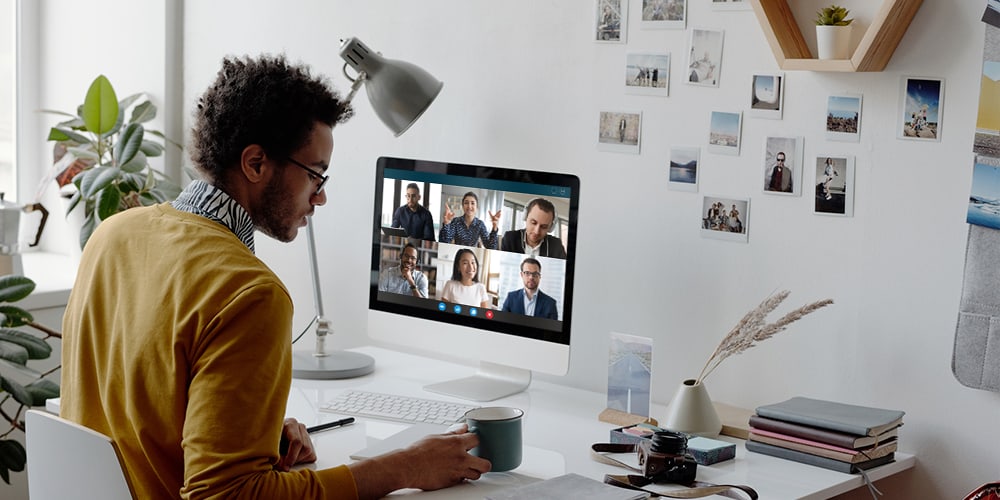Insider tips for recording professional webinars and online events at home.
19th May 2020 • 5 min read
19th May 2020 • 5 min read

We’ve seen a flurry of clients working hard to take physical events online. In some ways, webinars, virtual conferences or online talks are a world away from their physical counterparts. But they’re a great opportunity for B2B marketers to engage a wider audience and the barrier to entry is much lower than setting up a physical event.
So, if you want to take your events online, how can you make sure you and your speakers look as professional as possible – even if you’re presenting from your living room? As Torpedo’s Motion Director, here are a few tips I give to our clients.
To find the most flattering angle, and help your audience feel like you’re talking directly to them, position the webcam level with your eyes (or a bit higher) when you’re recording your event or webinar. Arrange your chair and your computer before you start and make sure your face isn’t too close or too far away from the camera.
Choose a neutral background when you’re setting up your shot. Your background shouldn’t be too bright or busy, and you should think about what objects and photos are in the shot. Are you happy to share these with everyone watching your event? Think carefully about the impression you want to give and make sure your background adds to it.
Now that services like Zoom and Microsoft Teams allow you to add your own backgrounds, why not raise your game with a background designed in your event branding?
If you can, sit with a window in front of you to light your face naturally. Don’t sit with lights or windows directly behind you, or you’ll look like a silhouette.
While daytime is the best time to record your video, you’ll need to watch out for direct sunlight: if the light is too strong, find another spot or use a blind or curtain to diffuse it.
If things look a little gloomy in your test shot, don’t be scared to use some lights. There are a couple of things you can do to improve the lighting with things you have at home:
Certain colours and patterns don’t work well on camera, so think carefully about your outfit. Of course, you should reflect your personal style, but try to keep distractions to a minimum and keep jewellery simple.
Make sure you know what you’re going to say before you start your recording or live event. Try doing a run through in front of a mirror, family member or pet. Or, if you’re confident you know your talk off by heart and can do it in one sitting, then go for it.
Some of our clients choose to pre-record their sessions and ask us to edit them so they’re as professional as possible. If you’re pre-recording your session, you don’t have to worry if you make a small mistake. Just repeat the correct version (there’s no need to stop the recording) and we’ll edit in the right version for you.
Once you’ve finished recording your session, make a note of what section of the recording relates to each of your slides. We’ll edit them in so they appear in the right place. If you’d prefer to record in sections, that’s an option too. Don’t change clothes or position in between sections and try to record all the sections quite close together to keep the light consistent. Our editors will put it together and make it flow.
You might be more worried about what you look like, but for your audience, sound quality is the most important thing.
Find a quiet room in your house, preferably somewhere which has ‘flat’ sound (i.e. no echoes). Big rooms with lots of hard surfaces like wooden floors tend to bounce sound around whereas smaller rooms with soft surfaces are better. Then, try to minimise other sounds in the room you’re in: turn off machines or fans that create ‘white noise’ and close the windows if it’s likely to be noisy outside.
Finally, do a test recording with your microphone. Listen to see whether the sound is clear, whether the microphone is too close or far away from your mouth and adjust accordingly. When we produce these kinds of events for our clients, we send them lapel mics which are simple to use and make a big difference to the sound quality.
If you’re going to be recording in a new location, or with new equipment, it’s always a good idea to record a test video. You can make sure your setup is giving you the look and sound quality you want and practise presenting in front of a camera. Even if you’re totally happy presenting in front of a live audience, recording yourself speaking on video will probably feel different, especially as you won’t get the eye contact or ‘read’ from the audience that you’re used to.
Just try to relax, smile and be yourself. If you’re recording your session, give yourself plenty of time to do as many takes as you need. Remember to be patient with yourself and try not to put yourself under too much pressure. Everyone’s feeling their way in the current situation.
Just a few small changes can make a big difference to how professional your online event looks. If you want to be really sure your event will be perfect, the best way is to record following this advice and then get your event branded and your footage professionally edited.

Talk to us about creating a virtual version of your next conference or event.
Get in touch